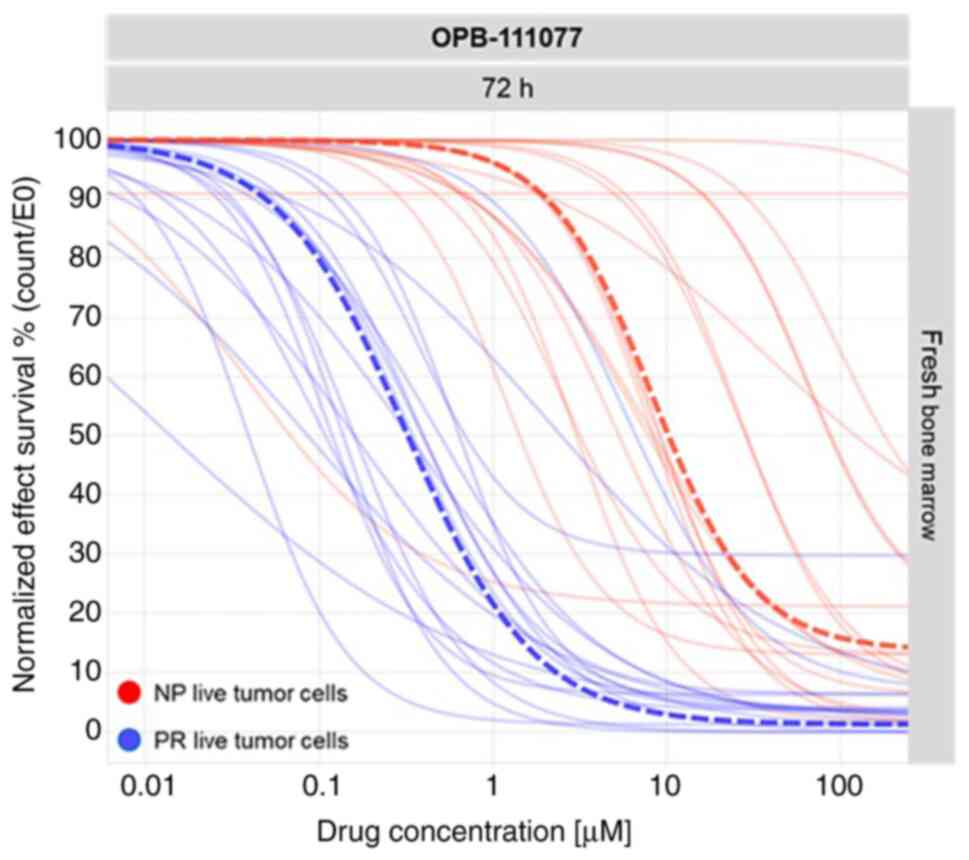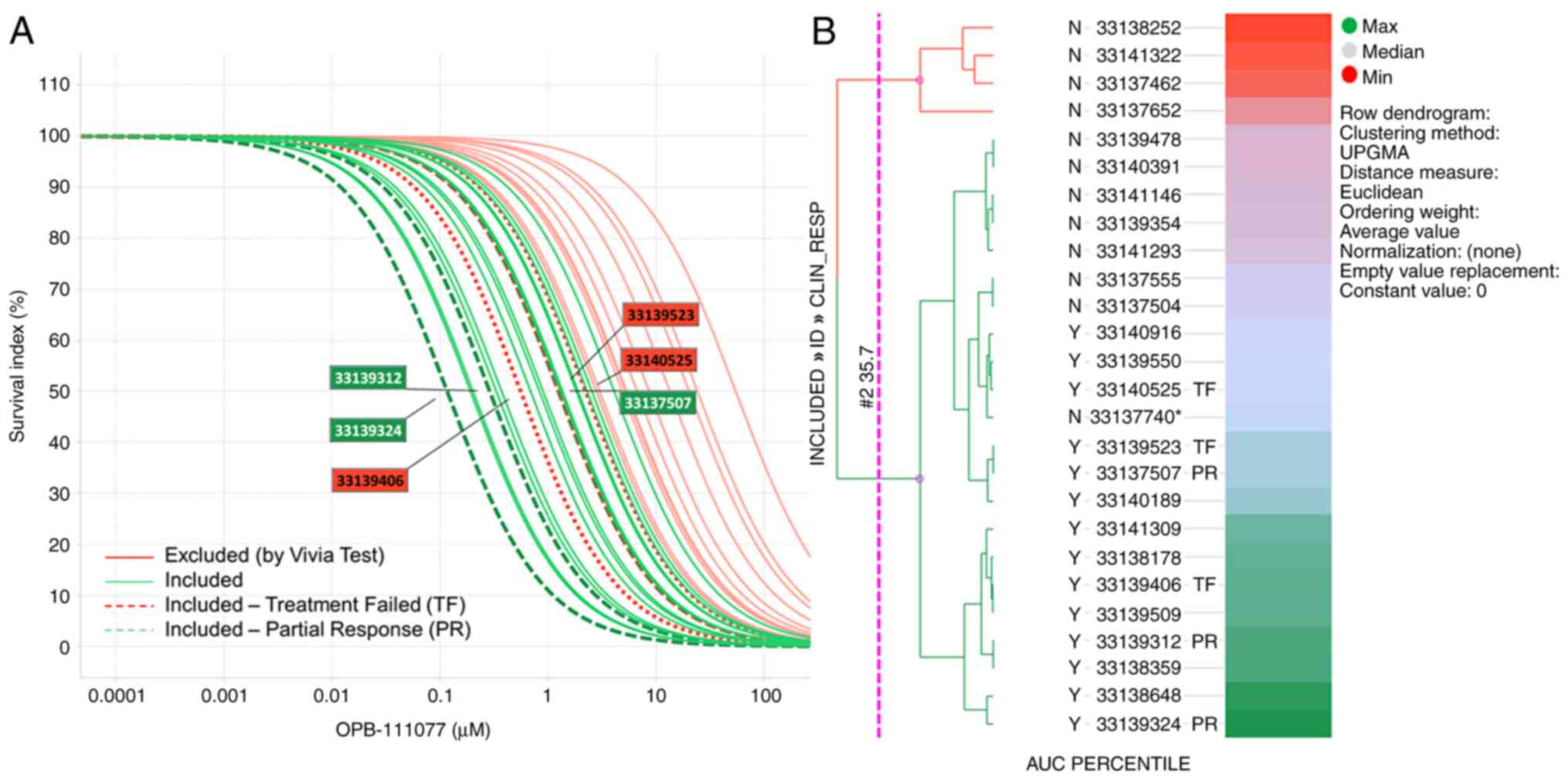|
1
|
Dohner H, Weisdorf DJ and Bloomfield CD:
Acute myeloid leukemia. N Engl J Med. 373:1136–1152.
2015.PubMed/NCBI View Article : Google Scholar
|
|
2
|
Löwenberg B: Prognostic factors in acute
myeloid leukaemia. Best Pract Res Clin Haematol. 14:65–75.
2001.PubMed/NCBI View Article : Google Scholar
|
|
3
|
Stone RM: The difficult problem of acute
myeloid leukemia in the older adult. CA Cancer J Clin. 52:363–371.
2002.PubMed/NCBI View Article : Google Scholar
|
|
4
|
Griffiths EA, Carraway HE, Chandhok NS and
Prebet T: Advances in non-intensive chemotherapy treatment options
for adults diagnosed with acute myeloid leukemia. Leuk Res.
91(106339)2020.PubMed/NCBI View Article : Google Scholar
|
|
5
|
Heuser M, Ofran Y, Boissel N, Brunet Mauri
S, Craddock C, Janssen J, Wierzbowska A and Buske C: Esmo
Guidelines Committee. Electronic address: simpleclinicalguidelines@esmo.org.
Acute myeloid leukaemia in adult patients: ESMO clinical practice
guidelines for diagnosis, treatment and follow-up. Ann Oncol.
31:697–712. 2020.PubMed/NCBI View Article : Google Scholar
|
|
6
|
Yilmaz M, Wang F, Loghavi S, Bueso-Ramos
C, Gumbs C, Little L, Song X, Zhang J, Kadia T, Borthakur G, et al:
Late relapse in acute myeloid leukemia (AML): Clonal evolution or
therapy-related leukemia? Blood Cancer J. 9(7)2019.PubMed/NCBI View Article : Google Scholar
|
|
7
|
Park S, Cho BS and Kim HJ: New agents in
acute myeloid leukemia (AML). Blood Res. 55:S14–S18.
2020.PubMed/NCBI View Article : Google Scholar
|
|
8
|
Guerra VA, DiNardo C and Konopleva M:
Venetoclax-based therapies for acute myeloid leukemia. Best Pract
Res Clin Haematol. 32:145–153. 2019.PubMed/NCBI View Article : Google Scholar
|
|
9
|
Tiong IS and Wei AH: New drugs creating
new challenges in acute myeloid leukemia. Genes Chromosomes Cancer.
58:903–914. 2019.PubMed/NCBI View Article : Google Scholar
|
|
10
|
Brachet-Botineau M, Polomski M, Neubauer
HA, Juen L, Hedou D, Viaud-Massuard MC, Prie G and Gouilleux F:
Pharmacological inhibition of oncogenic STAT3 and STAT5 signaling
in hematopoietic cancers. Cancers (Basel). 12(240)2020.PubMed/NCBI View Article : Google Scholar
|
|
11
|
Gu Y, Mohammad IS and Liu Z: Overview of
the STAT-3 signaling pathway in cancer and the development of
specific inhibitors. Oncol Lett. 19:2585–2594. 2020.PubMed/NCBI View Article : Google Scholar
|
|
12
|
Furqan M, Akinleye A, Mukhi N, Mittal V,
Chen Y and Liu D: STAT inhibitors for cancer therapy. J Hematol
Oncol. 6(90)2013.PubMed/NCBI View Article : Google Scholar
|
|
13
|
Meier JA and Larner AC: Toward a new
STATe: The role of STATs in mitochondrial function. Semin Immunol.
26:20–28. 2014.PubMed/NCBI View Article : Google Scholar
|
|
14
|
Benekli M, Baer MR, Baumann H and Wetzler
M: Signal transducer and activator of transcription proteins in
leukemias. Blood. 101:2940–2954. 2003.PubMed/NCBI View Article : Google Scholar
|
|
15
|
Ogura M, Uchida T, Terui Y, Hayakawa F,
Kobayashi Y, Taniwaki M, Takamatsu Y, Naoe T, Tobinai K, Munakata
W, et al: Phase I study of OPB-51602, an oral inhibitor of signal
transducer and activator of transcription 3, in patients with
relapsed/refractory hematological malignancies. Cancer Sci.
106:896–901. 2015.PubMed/NCBI View Article : Google Scholar
|
|
16
|
Tolcher A, Flaherty K, Shapiro GI, Berlin
J, Witzig T, Habermann T, Bullock A, Rock E, Elekes A, Lin C, et
al: A first-in-human phase I study of OPB-111077, a small-molecule
STAT3 and oxidative phosphorylation inhibitor, in patients with
advanced cancers. Oncologist. 23:658–e672. 2018.PubMed/NCBI View Article : Google Scholar
|
|
17
|
Yoo C, Kang J, Lim HY, Kim JH, Lee MA, Lee
KH, Kim TY and Ryoo BY: Phase I dose-finding study of OPB-111077, a
novel STAT3 inhibitor, in patients with advanced hepatocellular
carcinoma. Cancer Res Treat. 51:510–518. 2019.PubMed/NCBI View Article : Google Scholar
|
|
18
|
Kalia M: Biomarkers for personalized
oncology: Recent advances and future challenges. Metabolism. 64
(Suppl 1):S16–S21. 2015.PubMed/NCBI View Article : Google Scholar
|
|
19
|
Kuusanmäki H, Leppä AM, Pölönen P, Kontro
M, Dufva O, Deb D, Yadav B, Brück O, Kumar A, Everaus H, et al:
Phenotype-based drug screening reveals association between
venetoclax response and differentiation stage in acute myeloid
leukemia. Haematologica. 105:708–720. 2020.PubMed/NCBI View Article : Google Scholar
|
|
20
|
Martínez-Cuadrón D, Gil C, Serrano J,
Rodríguez G, Pérez-Oteyza J, García-Boyero R, Jiménez-Bravo S,
Vives S, Vidriales MB, Lavilla E, et al: A precision medicine test
predicts clinical response after idarubicin and cytarabine
induction therapy in AML patients. Leuk Res. 76:1–10.
2019.PubMed/NCBI View Article : Google Scholar
|
|
21
|
Vivia Biotech: PharmaFlow PM Test. 2020.
https://www.viviabiotech.com/pharmaflow-precision-medicine-test/.
Accessed October, 2021.
|
|
22
|
Bennett TA, Montesinos P, Moscardo F,
Martinez-Cuadron D, Martinez J, Sierra J, García R, de Oteyza JP,
Fernandez P, Serrano J, et al: Pharmacological profiles of acute
myeloid leukemia treatments in patient samples by automated flow
cytometry: A bridge to individualized medicine. Clin Lymphoma
Myeloma Leuk. 14:305–318. 2014.PubMed/NCBI View Article : Google Scholar
|
|
23
|
Common Terminology Criteria for Adverse
Events (CTCAE) Version 4.0. 2010. https://www.eortc.be/services/doc/ctc/CTCAE_4.03_2010-06-14_QuickReference_5x7.pdf.
Accessed September, 2020.
|
|
24
|
Cheson BD, Bennett JM, Kopecky KJ, Büchner
T, Willman CL, Estey EH, Schiffer CA, Doehner H, Tallman MS, Lister
TA, et al: Revised recommendations of the international working
group for diagnosis, standardization of response criteria,
treatment outcomes, and reporting standards for therapeutic trials
in acute myeloid leukemia. J Clin Oncol. 21:4642–4649.
2003.PubMed/NCBI View Article : Google Scholar
|
|
25
|
Bejanyan N, Weisdorf DJ, Logan BR, Wang
HL, Devine SM, de Lima M, Bunjes DW and Zhang MJ: Survival of
patients with acute myeloid leukemia relapsing after allogeneic
hematopoietic cell transplantation: A center for international
blood and marrow transplant research study. Biol Blood Marrow
Transplant. 21:454–459. 2015.PubMed/NCBI View Article : Google Scholar
|
|
26
|
Breems DA, Van Putten WL, Huijgens PC,
Ossenkoppele GJ, Verhoef GE, Verdonck LF, Vellenga E, De Greef GE,
Jacky E, Van der Lelie J, et al: Prognostic index for adult
patients with acute myeloid leukemia in first relapse. J Clin
Oncol. 23:1969–1978. 2005.PubMed/NCBI View Article : Google Scholar
|
|
27
|
Uy GL, Assouline S, Young AM, Blotner S,
Higgins B, Chen LC and Yee K: Phase 1 study of the MDM2 antagonist
RO6839921 in patients with acute myeloid leukemia. Invest New
Drugs. 38:1430–1441. 2020.PubMed/NCBI View Article : Google Scholar
|
|
28
|
Lee JH, Faderl S, Pagel JM, Jung CW, Yoon
SS, Pardanani AD, Becker PS, Lee H, Choi J, Lee K, et al: Phase 1
study of CWP232291 in patients with relapsed or refractory acute
myeloid leukemia and myelodysplastic syndrome. Blood Adv.
4:2032–2043. 2020.PubMed/NCBI View Article : Google Scholar
|
|
29
|
Webster JA and Pratz KW: Acute myeloid
leukemia in the elderly: Therapeutic options and choice. Leuk
Lymphoma. 59:274–287. 2018.PubMed/NCBI View Article : Google Scholar
|
|
30
|
Martinez-Lopez J, Montesinos P, Martinez
Sanchez P, Gorrochategui J, Rojas JL, Primo D, Bergua JM, Ayala RM,
Calbacho M, López Muñoz N, et al: Biomarker-driven phase Ib
clinical trial of OPB-111077 in acute myeloid leukemia increases
overall response rates. Blood. 136 (Suppl 1):18–19. 2020.
|
|
31
|
Lin L, Tong Y, Straube J, Zhao J, Gao Y,
Bai P, Li J, Wang J, Wang H, Wang X, et al: Ex-vivo drug testing
predicts chemosensitivity in acute myeloid leukemia. J Leukoc Biol.
107:859–870. 2020.PubMed/NCBI View Article : Google Scholar
|
|
32
|
Onecha E, Ruiz-Heredia Y, Martinez-Cuadron
D, Barragan E, Martinez-Sanchez P, Linares M, Rapado I,
Perez-Oteyza J, Magro E, Herrera P, et al: Improving the prediction
of acute myeloid leukaemia outcomes by complementing mutational
profiling with ex vivo chemosensitivity. Br J Haematol.
189:672–683. 2020.PubMed/NCBI View Article : Google Scholar
|
|
33
|
Wilde L, Martinez-Outschoorn U, Palmisiano
N and Kasner M: OPB-111077 in combination with decitabine and
venetoclax for the treatment of acute myeloid leukemia. Blood.
134:2597. 2019.
|
|
34
|
Ashton TM, McKenna WG, Kunz-Schughart LA
and Higgins GS: Oxidative phosphorylation as an emerging target in
cancer therapy. Clin Cancer Res. 24:2482–2490. 2018.PubMed/NCBI View Article : Google Scholar
|
|
35
|
Lee H, Jeong AJ and Ye SK: Highlighted
STAT3 as a potential drug target for cancer therapy. BMB Rep.
52:415–423. 2019.PubMed/NCBI View Article : Google Scholar
|
|
36
|
Tsuji A, Akao T, Masuya T, Murai M and
Miyoshi H: IACS-010759, a potent inhibitor of glycolysis-deficient
hypoxic tumor cells, inhibits mitochondrial respiratory complex I
through a unique mechanism. J Biol Chem. 295:7481–7491.
2020.PubMed/NCBI View Article : Google Scholar
|
|
37
|
Jeyaraju DV, Hurren R, Wang X, MacLean N,
Gronda M, Shamas-Din A, Minden MD, Giaever G and Schimmer AD: A
novel isoflavone, ME-344, targets the cytoskeleton in acute myeloid
leukemia. Oncotarget. 7:49777–49785. 2016.PubMed/NCBI View Article : Google Scholar
|
|
38
|
Wilde L, Martinez-Outschoorn U, Palmisiano
N, Keiffer G and Kasner M: Results of the phase 1b dose escalation
study of OPB-111077, decitabine, and venetoclax for the treatment
of newly diagnosed or relapsed/refractory AML. Blood.
136(10)2020.
|
|
39
|
Pollyea DA, Stevens BM, Jones CL, Winters
A, Pei S, Minhajuddin M, D'Alessandro A, Culp-Hill R, Riemondy KA,
Gillen AE, et al: Venetoclax with azacitidine disrupts energy
metabolism and targets leukemia stem cells in patients with acute
myeloid leukemia. Nat Med. 24:1859–1866. 2018.PubMed/NCBI View Article : Google Scholar
|
















